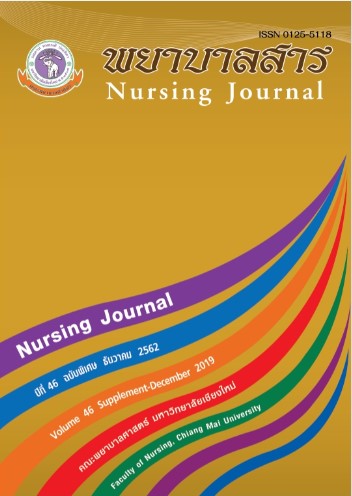Development of Eating Pattern for People with Uncontrolled Hypertension Using Family Participation Approach
Keywords:
Eating pattern, Uncontrolled Hypertension, Family participationAbstract
Eating the right foods for the disease is essential for controlling blood pressure level among hypertensive persons, therefore it is important that eating patterns suit the context and lifestyle of these persons. A developmental research design was used to conduct this study. This study aimed to develop eating patterns for people with uncontrolled hypertension using family participation based on the family participation concept from literature reviewed and to study the feasibility of using the eating pattern in real situations. The population in the study consisted of: people with uncontrolled hypertension (N=68) and family members of people with uncontrolled hypertension (N= 68), and people who involved in caring for people with high blood pressure in the community (N=11). The study instruments were comprised of: 1) Data collection tools; (1) People with Uncontrolled Hypertension Eating Questionnaire, (2) Family Members Eating Questionnaire, (3) Focus Group discussion guide for Village Healthcare Volunteers and Health promoting Hospital Staff, (4) Feasibility of Using the Eating Pattern in Real Situation Questionnaire, and (2) Developmental Plan of the eating pattern for people with uncontrolled hypertension using family participation approach. The questionnaire content validity were test and CVI are 0.927, 0.99 and 1.00 respectively. The questionnaire reliability were test by using Cronbach's alpha coefficient formula, the reliability is 0.88 and 0.82 respectively. The data were analyzed using descriptive statistics and qualitative analysis.
Two main results were found. The first documented that eating patterns were comprised of three main ideas: increasing consumption of vegetables, following a low salt diet, and appropriate eating. The second finding showed that the eating pattern developed in this study was suitable for the lifestyle of persons with the uncontrolled hypertension and their family members at a moderate level (x̄=2.50, S.D. = 0.62) and was feasible. (x̄=2.47, S.D.= 0.61). Therefore, it is important to use mass media to provide more information about eating patterns to highlight the future benefits for uncontrolled hypertensive persons. Communities should encourage this group and their family members to use the eating plan and promote this eating pattern in the community. Moreover, in the future, the eating plan should include recipes for hypertensives that use local vegetables known to lower high blood pressure. These recipes should be easy for to prepare.
References
Creighton, L. J. (2005). The Public Participation Handbook: Making Better Decisions through
Citizen Involvement. USA: Jossey Bass.
Department of Health, Bureau of Nutrition. (2012). Eat a little less salty- Conquer high blood
pressure. Bangkok: Suan Sunandha Rajabhat University. (In Thai)
Hattakosol C. (2014). Hunger, appetite, and satiety. Retrieved May 20, 2015, from
http://www.thaihealth.or.th/Content/24563.html (In Thai)
Keawtep, K., Nilpueng, K., & Janejud, R. (2013). Health-food-communication. Bangkok: Parp
Pim. (In Thai)
Ministry of Public Health, Department of Disease Control. (2013). Report of form review on the
prevention of non-communicable diseases from life-style By reducing salt intake. Bangkok: Veterans Relief Organization. (In Thai)
Ministry of Health, Department of Disease Control, Bureau of Epidemiology. (2013). Report of
chronic non-communicable disease surveillance 2011. Retrieved May 20, 2014, from http://www.boe.moph.go.th/ Annual/AESR2013/ wesr_2556 %20digital/wk56_10.pdf. (In Thai)
Ministry of Public Health, Department of Medical Services. (2006). Clinical practice guidelines
for nutrition therapy in patients Diabetes, high blood pressure And people with
dyslipidemia for the elderly. Bangkok: Agricultural Gathering of Thailand. (In Thai)
Ministry of Public Health, Office of Policy and Strategy. (2013). Summary of important national
statistics 2013. Retrieved May 20, 2014, from http://www.m-society.go.th/article _attach/11378/15693.pdf. (In Thai)
Ministry of Public Health, Office of Policy and Strategy. (2013). Thailand Healthy Life-style
Strategic Plan 2011-2020. Retrieved May 20, 2014, from http://wops.moph.go.th /ops/oic/data/20110316100703_1_.pdf. (In Thai)
Namchantra, R. (2009). Patient-and Family-centered Care: A Challenge Model of
Healthcare Services. Thai Journal of Nursing Council, 24(1). 5-10. (In Thai)
National Heart Lung and Blood Institute. (2006). Your guide to Lowering your blood pressure
with DASH: DASH diet eating plan. USA: U.S. Department of health and human
service.
Promsao, K., & Bensilaraksa, N. (1999). Trace the Thai recipe. Chiang Mai: Wannarak. (In
Thai)
Ramitanon, C., Satienpatanapongsa, C., Kasikam, P., & Maneelert, T. (2000). Eating culture of
Norther Thai People. Chiang Mai: Ming-muang (In Thai)
Sakayapant, S. (2005). Local food recipe. Chiang Mai: Chiang Mai Rajabhat University. (In Thai)
Scholl, J. (2012). Traditional Dietary Recommendations for the Prevention of Cardiovascular
Disease: Do They Meet the Needs of Our Patients?. Hindawi Publishing Corporation Cholesteral. doi: 10.1155/2012/367898
Sittijumroon C. (2013). Modern medicine 2013 : Obesity and appetite control. Bangkok: P. A.
Living. (In Thai)
Srimuang P. (2012). Healthy food and nutrition therapy. Bangkok: M and M Laserprint.(In Thai)
Supanimityothin P. (2013). Food and nutrition. Bangkok: O. S. Printing House. (In Thai)
Thai Hypertension Society. (2015). Introduce to Thai guidelines on the treatment of
hypertension update 2015. Retrieved October 20, 2015, from http://thaihypertension.org /files/297.2015%20Conference%20-%20Document.pdf. (In Thai)
Wengreen, H., Munger, R. G., Cutler, A., Quach, A., Bowles, A., Corcoran, C., …& Welsh-
Bohmer K. A. (2013). Prospective study of Dietary Approaches to Stop Hypertension– and Mediterranean-style dietary patterns and age-related cognitive change: the Cache County Study on Memory, Health and Aging. The American journal of clinical nutrition, 98, 1263-1271.
Wongtib, U. (2015). Development of Hypertension Prevention Program among People at Risk by Community Participation. Nursing Journal. 42(4), 12-24. (In Thai)
World Health Organization. (1986). The Ottawa Charter for Health Promotion. Retrieved July 27,
2015, from http://www.who.int/healthpromotion/conferences/previous/ottawa/en/
Yang-Noey Health Promoting Hospital. (2014). PCA Report (Fiscal year 2014) Yang-Noey Health
Promoting Hospital. Chiang nai: Author. (In Thai)
Downloads
Published
How to Cite
Issue
Section
License
บทความที่ได้รับการตีพิมพ์เป็นลิขสิทธิ์ของวารสารพยาบาลสาร
ข้อความที่ปรากฏในบทความแต่ละเรื่องในวารสารวิชาการเล่มนี้เป็นความคิดเห็นส่วนตัวของผู้เขียนแต่ละท่านไม่เกี่ยวข้องกับมหาวิทยาลัยเชียงใหม่ และคณาจารย์ท่านอื่นๆในมหาวิทยาลัยฯ แต่อย่างใด ความรับผิดชอบองค์ประกอบทั้งหมดของบทความแต่ละเรื่องเป็นของผู้เขียนแต่ละท่าน หากมีความผิดพลาดใด ๆ ผู้เขียนแต่ละท่านจะรับผิดชอบบทความของตนเองแต่ผู้เดียว






